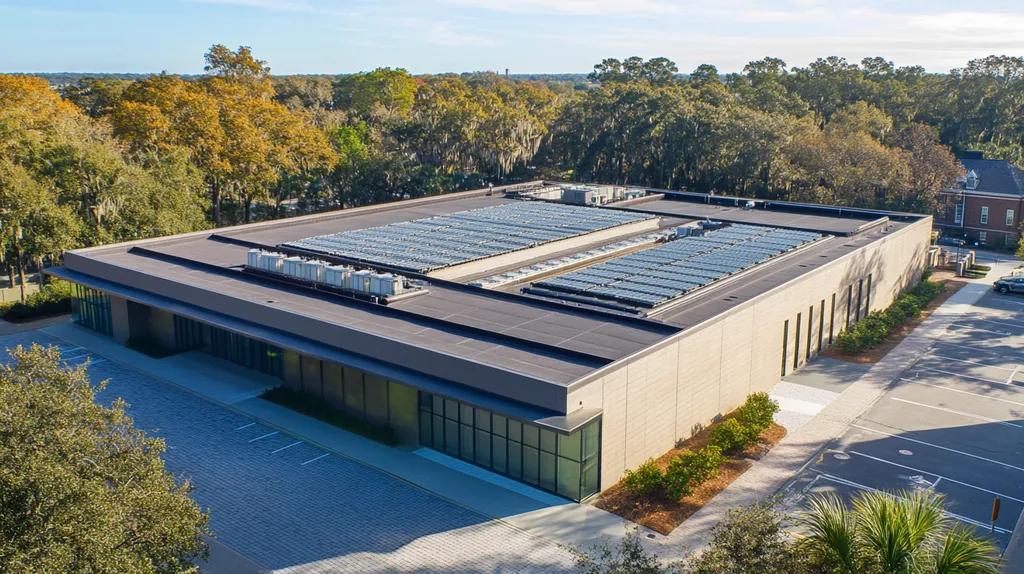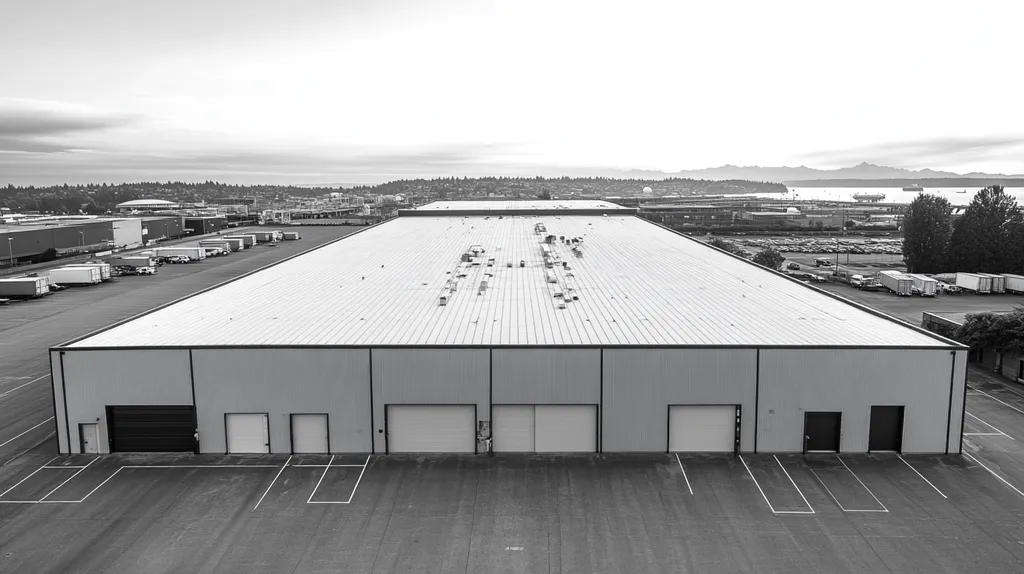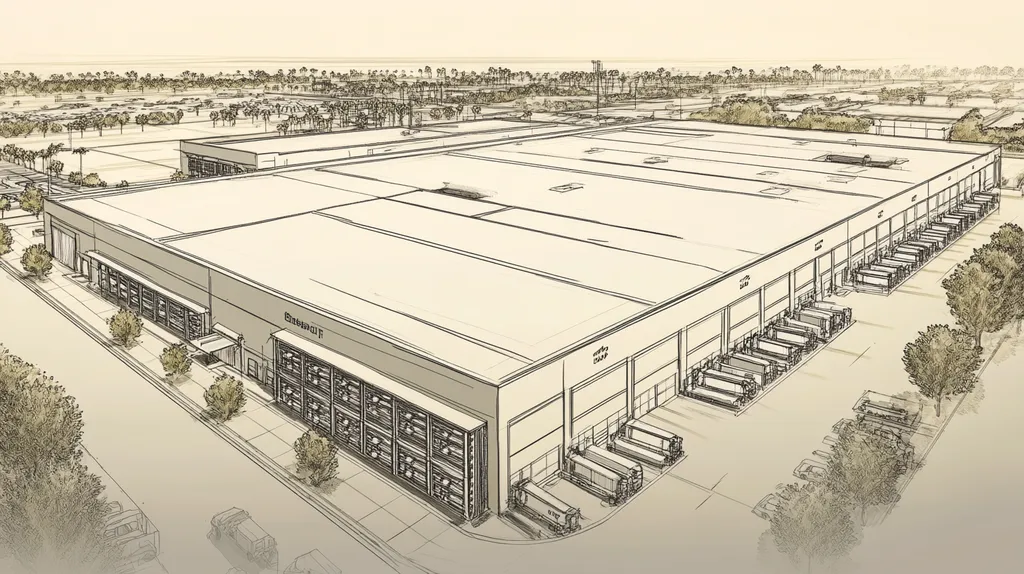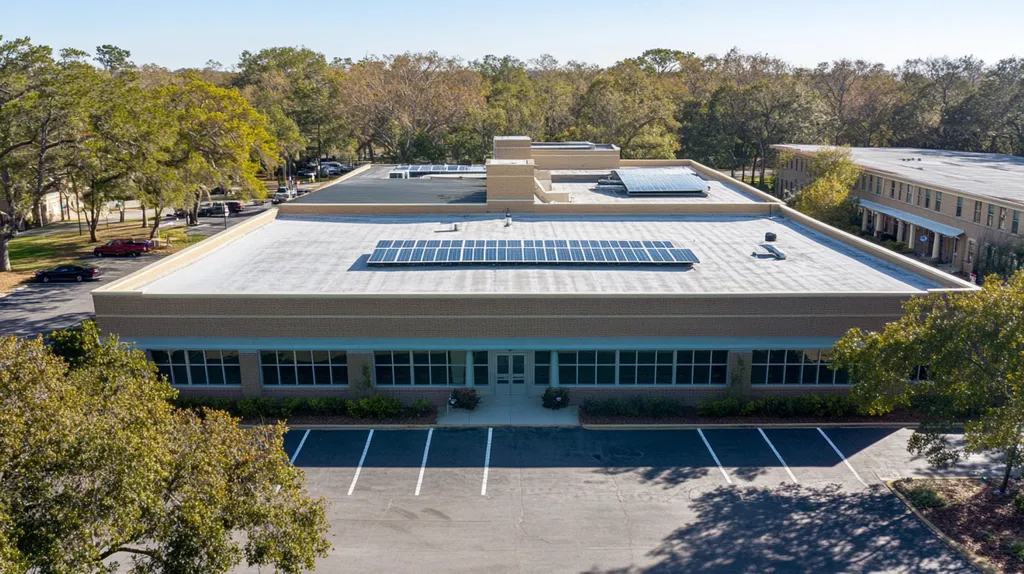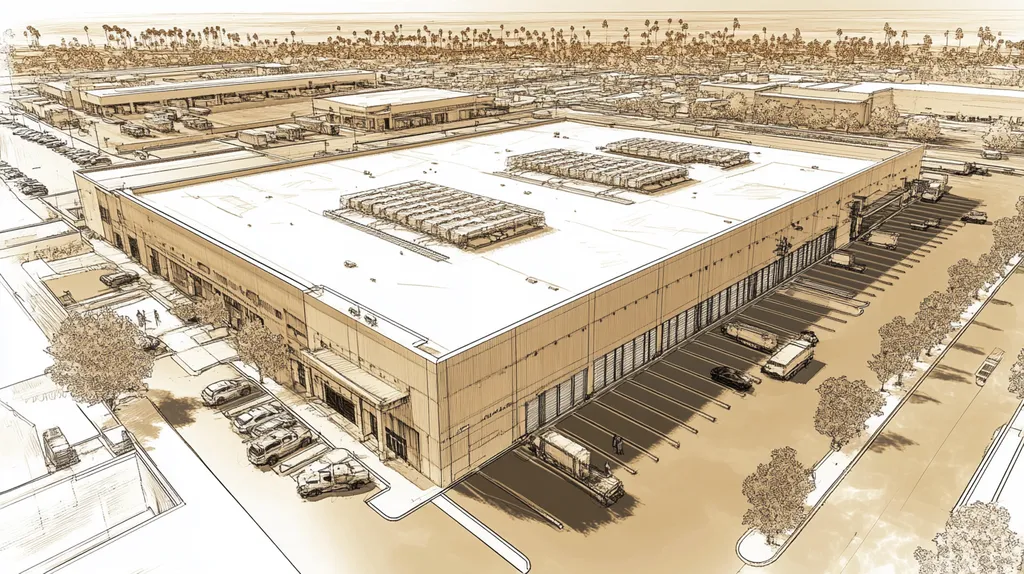Every year, commercial property owners lose millions in revenue due to improperly timed roof coating installations. Industry data reveals that 40% of coating failures stem directly from seasonal application challenges.
From temperature fluctuations that compromise adhesion to moisture issues that void warranties, facility managers face mounting pressure to navigate complex seasonal variables.
This comprehensive guide examines critical factors affecting coating performance across seasons, providing actionable solutions for property owners and facility managers to optimize installation timing, ensure compliance, and protect their roofing investments.
SECTION 1: PERFORMANCE FACTORS
The effectiveness of roof coatings is heavily influenced by seasonal temperature fluctuations. Coatings applied under extreme conditions often fail to adhere correctly, leading to expensive repairs. Facility managers must navigate these challenges, as inadequate coatings can crack or peel, leaving roofs vulnerable and potentially compromising a building’s structural integrity. A clear understanding of performance factors is crucial for making sound decisions regarding roof coating installations.
Impact of Temperature Fluctuations
Temperature plays a critical role in the application and drying of roofing materials. For example, if a coating is applied in very cold weather, it may remain tacky and fail to bond effectively. Conversely, extreme heat can cause the material to cure too quickly, preventing it from leveling and adhering properly.
These extreme temperature variations can create a mismatch between the coating and the roof surface. If the roof is too hot, the upper layer might dry out before the underlying layers are fully cured, decreasing adhesion strength and increasing the risk of water intrusion.
This isn’t just a short-term issue; the impact on long-term durability can be profound. Facility managers need to closely monitor temperatures during coating installation to maximize performance and minimize future costs. Moreover, applying coatings outside of recommended temperature ranges can void warranties, underscoring the necessity for thorough temperature oversight.
Key Action Items
Effects of Freeze-Thaw-Freeze Cycle
The freeze-thaw-freeze cycle presents significant challenges for newly applied roof coatings, particularly in regions with severe winters. During warmer temperatures, moisture can penetrate roofing materials, and upon freezing, this moisture expands, leading to cracks and stress points in the coating.
This cycle endangers not only the coatings but also the roof membrane itself. Over time, recurring freeze-thaw cycles can accelerate material deterioration, resulting in leaks and extensive damage. Facility managers must proactively monitor weather patterns before and after a coating application.
By planning timelines carefully and keeping an eye on weather forecasts, managers can reduce the risk of premature coating failures. Protecting against freeze-thaw effects is essential not only for maintaining integrity but also for preventing costly interior repairs due to leaks.
Key Action Items
Material Deterioration and Brittleness
Every roofing material has a finite lifespan influenced by seasonal elements, such as UV exposure and temperature extremes. For instance, UV rays can degrade protective surfaces on coatings, while extremely cold conditions can cause materials to become brittle and crack. These factors can significantly shorten the lifespan of a roof, necessitating earlier interventions than planned.
Brittleness in coatings also makes them more vulnerable to physical impacts, whether from debris or thermal changes. When coatings become stiff and inflexible, they struggle to adapt to slight movements caused by thermal expansion, increasing the risk of peeling and delamination.
To ensure the longevity of roof coatings, facility managers should regularly evaluate their condition as part of routine maintenance. Recognizing signs of wear, such as discoloration or excessive brittleness, will allow for timely repairs or replacements, ultimately saving significant costs in the long run.
Key Action Items
SECTION 2: FINANCIAL CONSIDERATIONS
Facility managers must grasp the financial implications of roof coating installations, especially given the seasonal challenges that impact costs and maintenance. When approached thoughtfully, effective budgeting and planning can greatly reduce financial risks while enhancing overall property value. This section will explore the costs associated with preventive maintenance, the savings potential from roof coatings, and strategies for budgeting seasonal repairs.
Cost of Preventive Maintenance
While preventive maintenance might seem like an unnecessary cost, it actually offers significant savings over time. Regular inspections and minor repairs address issues before they become major expenses, ultimately extending the life of the roof.
A well-maintained roof can last 20-30 years longer than a neglected one. For example, investing in preventative measures can make the difference between fixing a small leak or facing the hefty price of a complete roof replacement.
By adopting a preventive maintenance plan, facility managers not only reduce unexpected downtimes but also ensure a stable occupancy rate in the building. In addition, many materials come with warranties, allowing property owners to safeguard their investments effectively.
Key Action Items
Savings Through Roof Coating
Roof coatings offer a protective layer that can dramatically extend a commercial roof’s life. By reflecting harmful UV rays and resisting weathering, these coatings help lower cooling costs, leading to notable savings on energy bills during sweltering months.
Moreover, effective coatings can prevent leaks and water damage, which translates to avoiding costly repairs down the line. Facilities investing in quality coatings often find they recover their initial investment in just a few years.
Additionally, many manufacturers provide warranties on coatings, offering financial protection that allows facility managers to budget confidently and avoid unexpected costs. Tax benefits may also be available, as energy-efficient upgrades could qualify for tax credits, making roof coatings an economically savvy choice.
Key Action Items
Budgeting for Seasonal Repairs
Seasonal changes often bring unexpected roof repairs that can strain budgets. To counteract these risks, facility managers should develop a comprehensive annual budget that anticipates potential repairs, including routine inspections before severe weather hits.
Creating a maintenance reserve fund is essential; a common guideline is to set aside 1-3% of the roof’s replacement cost each year. This proactive strategy can protect against sudden, large expenses and ensures financial stability.
Incorporating contingencies for seasonal repairs into the budget offers quicker response times for any emerging issues. Such planning not only preserves the roof’s integrity but also ensures compliance with necessary insurance mandates.
Key Action Items
SECTION 3: COMPLIANCE REQUIREMENTS
Navigating the complex landscape of regulatory compliance is a vital task for facility managers and property owners alike. Failing to adhere to health, safety, and environmental regulations can have dire financial and legal consequences. Alarmingly, almost 40% of facility managers have encountered compliance issues during roof maintenance. This section delves into the key compliance requirements that impact roof coating installations.
Regulatory Standards for Roofing
Understanding and adhering to regulatory standards is critical for successful roofing projects. Authorities like the Occupational Safety and Health Administration (OSHA) and local building codes lay out essential guidelines, particularly regarding fire safety, wind resistance, and waterproofing of roofing materials.
Non-compliance can lead not only to costly fines but also to structural failures that jeopardize safety. Additionally, organizations might face increased insurance premiums or even legal action. Regular consultations with roofing professionals can ensure that all coatings meet necessary regulations and standards.
Documentation and safety inspections are essential for maintaining compliance. Keeping accurate records demonstrates conformity with all standards, helping to prevent disputes. Facility managers should conduct regular audits to identify any compliance gaps before they evolve into larger issues.
Staying informed about ever-changing regulations is an ongoing challenge. It’s crucial for facility managers to continually update their knowledge regarding local, state, and federal roofing laws, as these can vary with shifting policies.
Key Action Items
Safety Protocols and Inspections
Robust safety protocols are not just guidelines; they are imperative for any roof coating installation. A single oversight can lead to accidents, jeopardizing worker safety and incurring significant liabilities. Data shows that roofing job site accidents can result in penalties reaching up to $25,000.
Developing a comprehensive safety plan before commencing any roofing project is indispensable. This plan should detail worker training, required protective gear, and adhere to OSHA safety protocols. Conducting regular safety inspections can identify potential hazards before they escalate.
Moreover, keeping a documented safety history protects the facility in case of incidents. Facilities managers should foster open dialogues among roofing teams to swiftly address any safety concerns. Regular tailgate meetings can help keep safety as a priority.
Finally, when selecting contractors, evaluate their safety records. Partnering with safety-focused contractors promotes a culture of care, leading to better project outcomes.
Key Action Items
Environmental Compliance
In today’s eco-conscious market, environmental compliance is paramount. Strict regulations govern how roofing materials should be managed to protect our planet. The U.S. Environmental Protection Agency (EPA) enforces guidelines for the safe disposal of hazardous substances.
Some roof coating materials contain volatile organic compounds (VOCs), which can be harmful. Facility managers should opt for low-VOC or VOC-free products to stay compliant with environmental regulations. Non-adherence to these standards can lead to serious penalties and damage a facility’s reputation.
Furthermore, the methods of installation should reflect sustainability considerations. Employing eco-friendly practices, such as recycling old roofing materials or using coatings that enhance energy efficiency, can aid in compliance and contribute to wider environmental goals.
Engaging with environmental specialists can provide additional insights into compliant practices. They can assist facility managers in implementing the best strategies that align with current regulations while fostering ecological responsibility.
Key Action Items
SECTION 4: RISK MANAGEMENT
In the commercial roofing sector, even minor oversights can lead to major financial consequences. Studies indicate that water damage constitutes up to 50% of all commercial insurance claims. For facility managers, identifying vulnerabilities and implementing proactive measures against seasonal challenges is essential. This section outlines strategies for managing risks associated with roof coatings, safeguarding investments, and ensuring long-term performance.
Identifying Potential Leak Areas
Detecting areas on a roof that are prone to leaks is vital for effective risk management. Typical leak-prone zones include seams, penetrations, and poorly drained areas. Ignoring these locations can lead to leaks that threaten the integrity of the entire roofing system.
Prior to coating installation, performing a comprehensive inspection with infrared technology can help identify hidden moisture problems before they escalate. Addressing these leaks early can prevent substantial repair expenses in the future.
Conducting regular maintenance evaluations also allows for the detection of wear caused by seasonal conditions such as wind, hail, or snow. Facility managers should document their inspections, paying close attention to regions previously identified as leak-prone or damaged.
Key Action Items
Mitigating Storm Damage
Severe weather can severely damage roofs, resulting in expensive repairs and increased downtime. Facility managers should analyze historical weather patterns to anticipate seasonal storms that may impact roofing systems.
Implementing protective measures such as reinforced edges and enhanced drainage systems can significantly reduce storm damage risks. Using high-quality materials specifically designed for the region’s environmental conditions is equally important.
Before a storm arrives, ensuring roof penetrations are secure and storm drains are unobstructed can prevent costly water damage. Establishing a comprehensive emergency response plan prepares facility managers for swift action in the event of storm-related issues.
Key Action Items
Preventing Structural Failures
Structural failures often stem from inadequate load management and poor installation methods. Facility managers must ensure their roofing systems can adequately bear seasonal loads, like snow accumulation or heavy rainfall, to avoid catastrophic failures.
Conducting regular assessments helps identify stress points within the roofing system, including a close examination of insulation and deck conditions, especially after extreme weather events.
Choosing professional-grade roofing materials designed to endure specific loads and conditions is crucial. This safeguards against structural failures while extending the overall lifespan of the roof.
Key Action Items
SECTION 5: OPERATIONAL PROCEDURES
As winter draws near, the reliability of commercial roof coatings faces significant challenges. Seasonal changes can lead to unpredictable weather, including freezing temperatures and heavy snowfalls that affect installation quality. If these issues are not addressed, they can cause long-term damage and result in costly repairs for property owners. This section outlines critical operational procedures, including a pre-winter inspection checklist, the importance of clearing drainage systems, and best practices for applying roof coatings.
Pre-Winter Inspection Checklist
A thorough pre-winter inspection is vital for evaluating the condition of a commercial roof. Facility managers should identify possible weak spots before frigid temperatures arrive. This includes searching for cracks, tears, or blisters that could worsen in freezing weather.
Evaluating rooftop equipment, such as HVAC units and vents, is equally important. Ensuring these installations are secure and free of debris can prevent leaks and other problems during winter months.
Additionally, inspectors should pay close attention to flashing and seams, which are often the most vulnerable areas. Addressing any damage here can help avoid water infiltration during rain or melting snow.
Key Action Items
Clearing Drainage Systems
Effective drainage is crucial for preventing water accumulation on roofs, particularly during winter. Blocked gutters and downspouts can cause water backup, leading to ice dams and structural issues. It’s essential to clear all drainage systems of leaves, debris, and blockages before winter arrives.
Facility managers should also verify that drains are functioning properly. Ensuring they are sound enough to handle increased precipitation is vital for minimizing winter-related risks.
Consider adding protective features like strainers or screens to drains, which can help prevent future debris buildup. Proactive maintenance of drainage systems will not only extend roof life but also enhance overall roof performance, minimizing emergency repair needs.
Key Action Items
Applying Roof Coatings
The timing of roof coating application is crucial for successful outcomes. Cold winter temperatures can adversely affect both adhesion and curing processes, making it preferable to apply coatings during warmer months. However, if application must occur in winter, use products specifically designed for lower temperatures.
Always adhere to manufacturer guidelines to ensure proper installation. Avoid applying coatings in wet or overly humid conditions, as moisture can hinder adhesion and lead to early deterioration.
Finally, make sure that application surfaces are thoroughly cleaned and free of contaminants. Proper surface preparation significantly contributes to the longevity of the coating and the overall condition of the roofing system.
Key Action Items
SECTION 5: OPERATIONAL PROCEDURES
As winter approaches, the integrity of commercial roof coatings faces significant challenges. Seasonal changes can lead to unpredictable weather, including freezing temperatures and heavy snow, which impact installation quality. Addressing these issues promptly is crucial, as neglect can result in long-term damage and costly repairs for property owners. This section outlines essential operational procedures, including a pre-winter inspection checklist, the importance of clearing drainage systems, and best practices for applying roof coatings.
Pre-Winter Inspection Checklist
A thorough pre-winter inspection is vital for assessing the condition of a commercial roof. Facility managers must proactively identify potential vulnerabilities before the freeze sets in. This includes looking for cracks, tears, or blisters that can expand and worsen in frigid conditions.
Evaluating rooftop equipment, such as HVAC units and vents, also plays a critical role. Ensuring these installations are secure and free from debris can mitigate leaks or other complications during the winter months.
Flashing and seams warrant careful examination as well, as they are often the most vulnerable areas on a roof. Addressing any damage promptly helps prevent water infiltration during rain or snowmelt.
Cruucially, hiring a qualified roofing professional for the inspection ensures a thorough evaluation and highlights necessary repair work or maintenance activities.
Key Action Items
Clearing Drainage Systems
Effective drainage is crucial for preventing water accumulation on roofs, especially during winter. Blocked gutters and downspouts can lead to water backup, creating ice dams and structural problems. It is essential to clear all drainage systems of leaves, debris, and blockages before the winter season arrives.
Facility managers should inspect drains to ensure they function correctly. Their ability to handle increased precipitation is vital for mitigating winter-related risks.
Moreover, consider adding protective features like strainers or screens to drains to minimize future debris build-up. Implementing proactive maintenance of drainage systems will not only extend the roof’s life but also enhance its overall performance, reducing emergency repair costs.
Key Action Items
Applying Roof Coatings
The timing of roof coating application is crucial for ensuring successful outcomes. Cold winter temperatures can negatively impact both adhesion and curing processes, making it preferable to apply coatings during warmer months. However, if winter application becomes necessary, use products specifically formulated for lower temperatures.
Always adhere to manufacturer guidelines for optimal installation results. Avoid applying coatings when conditions are wet or overly humid, as moisture can hinder adhesion and lead to premature deterioration.
Choose a clear day with mild temperatures for application and ensure all surfaces are thoroughly cleaned and free of contaminants. Adequate surface preparation significantly contributes to the longevity of the coating and the overall health of the roofing system.
Key Action Items
Looking Ahead
With 40% of commercial roof coating failures directly tied to seasonal application challenges, facility managers can no longer afford to ignore proper timing and preparation.
The financial implications are clear – improper installations lead to premature coating breakdown, increased energy costs, and potential structural damage that can cost organizations millions annually.
By following established protocols for temperature monitoring, surface preparation, and weather tracking, property managers can dramatically reduce the risk of coating failures while maximizing their return on investment.
The future of commercial roofing depends on balancing seasonal constraints with evolving coating technologies and stricter environmental regulations.
Those who adapt their maintenance programs to address these challenges will be best positioned to protect their facilities and maximize the lifespan of their roofing assets.
FREQUENTLY ASKED QUESTIONS
Q. How do temperature fluctuations affect commercial roof coatings?
A. Temperature plays a critical role in roof coating effectiveness. Extreme cold can prevent bonding, while excessive heat may cause coatings to cure too quickly. Regular monitoring of temperature during application ensures adherence and reduces the risk of premature failures, which can lead to costly repairs.
Q. What financial considerations should I take for industrial roof maintenance?
A. Understanding budgetary implications is crucial for managing roof maintenance costs. Allocating funds for routine inspections and preventive measures ultimately saves money and enhances property value. Through strategic planning, facility managers can mitigate unexpected repair expenses and extend the roof’s lifespan.
Q. What are the compliance requirements for commercial roof projects?
A. Compliance with regulations like OSHA and local building codes is essential. These guidelines cover safety protocols, fire resistance, and waterproofing requirements. Regular audits and documentation help facility managers maintain compliance and avoid potential fines or legal troubles, ensuring safe and efficient roofing projects.
Q. How can I identify potential leak areas on my commercial roof?
A. Regular inspections focusing on seams, penetrations, and drainage areas are key to identifying vulnerabilities. Utilizing infrared technology can reveal hidden moisture issues before they worsen. Document inspections thoroughly and address minor leaks proactively to prevent major repair costs in the future.
Q. What operational procedures should I follow during winter for my roof?
A. Conduct thorough pre-winter inspections to assess roof health, ensuring vulnerabilities are addressed. Clear drainage systems of debris to prevent ice dams, and follow manufacturer guidelines for any coating applications during colder months. This proactive approach safeguards against long-term damage and costly repairs.
Q. What are the best practices for applying roof coatings?
A. For optimal results, schedule applications during warmer months and ensure surfaces are clean. Avoid applications during wet or humid conditions, as this can hinder adhesion. Following manufacturer guidelines and documenting procedures can significantly contribute to the longevity of the coating.
Q. How can roof coatings contribute to energy efficiency?
A. Roof coatings can enhance energy efficiency by reflecting UV rays, thus reducing cooling costs. An efficient coating minimizes wear from harsh elements, contributing to the roof’s longevity. Over time, this leads to significant savings on energy bills while supporting a greener environment.

